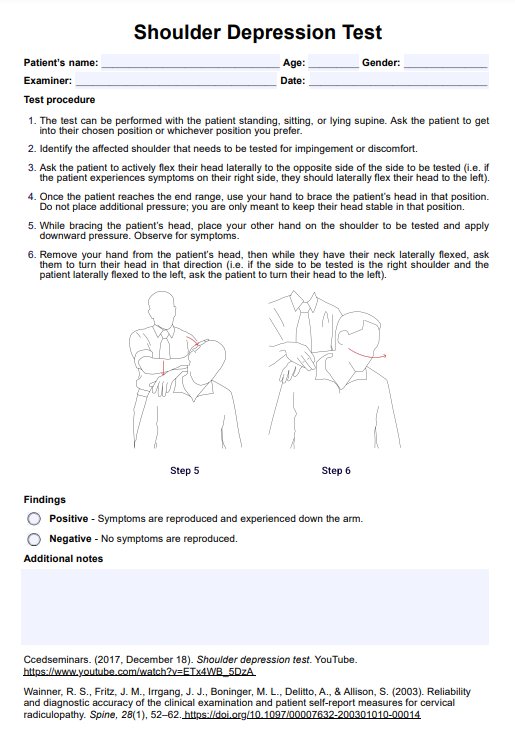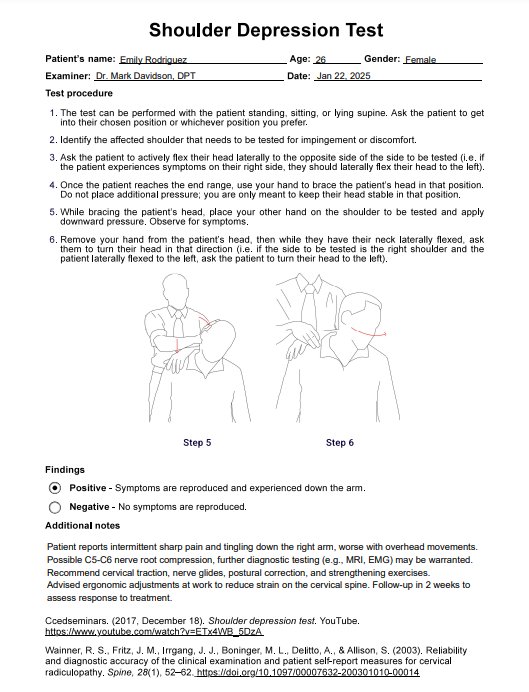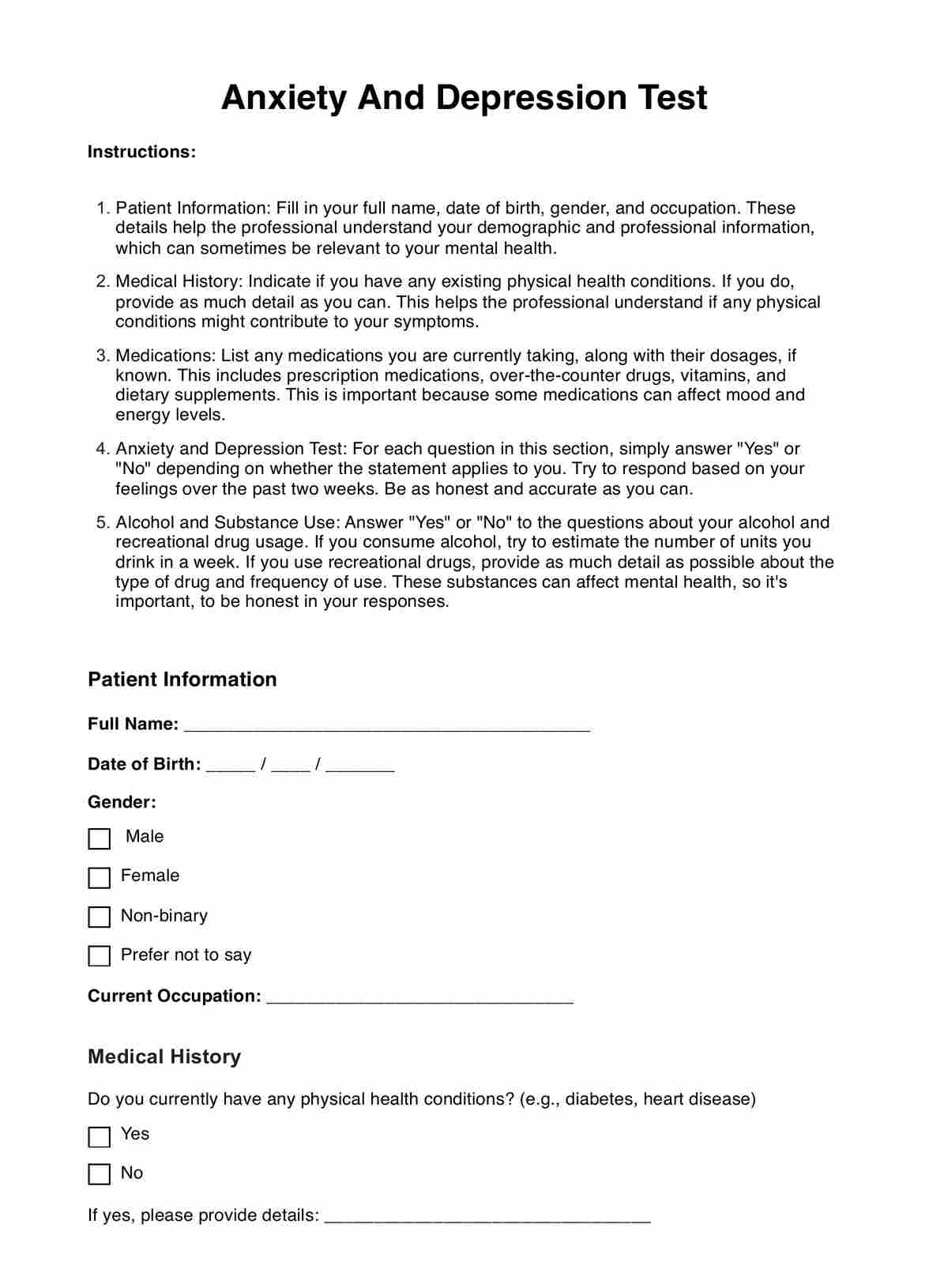Shoulder Depression Test
Try out our free Shoulder Depression Test template—streamline your cervical radiculopathy assessments and help patients identify their conditions.


The Shoulder Depression Test
The Shoulder Depression Test is a clinical examination used to assess the presence of cervical nerve root compression in individuals with suspected cervical radiculopathy. It is one of the many shoulder-specific tests in the orthopedic physical assessment.
During this test, the patient's head is passively depressed towards the unaffected side while maintaining an upright sitting position. The examiner then applies downward pressure on the patient's shoulder while monitoring for any reproduction of pain or other radicular symptoms in the arm.
This test is based on the principle that shoulder depression increases foraminal space and reduces pressure on the nerve roots, potentially relieving symptoms in cases of nerve root compression.
Shoulder Depression Test Template
Shoulder Depression Test Example
An overview of the shoulder and its functions
The shoulder is a complex and versatile joint essential for various daily activities, providing both stability and mobility to the upper limb. It is composed of three bones—the clavicle (collarbone), scapula (shoulder blade), and humerus (upper arm bone)—which form four distinct joints: the sternoclavicular, acromioclavicular, glenohumeral, and scapulothoracic joints. Together, these structures enable a wide range of motion, such as lifting, reaching, pushing, and pulling, making the shoulder one of the most mobile joints in the body (Miniato et al., 2019; Epperson & Varacallo, 2019).
This intricate structure relies on a network of muscles, tendons, and ligaments for stability and functionality. The rotator cuff, a group of four muscles, plays a vital role in stabilizing the shoulder joint and facilitating rotation. Meanwhile, the clavicle acts as a support strut, stabilizing shoulder movements (American Academy of Orthopaedic Surgeons, 2010). Any injury or dysfunction in these components can significantly impair shoulder performance and lead to discomfort or limited mobility.
The shoulder is prone to several injuries and conditions due to its frequent use and structural complexity:
- Rotator cuff tears: These injuries involve one or more muscles of the rotator cuff and can result from acute trauma or degenerative wear over time (Mayo Clinic, 2023).
- Shoulder impingement syndrome: This occurs when the soft tissues of the shoulder become compressed between bones, leading to pain and restricted movement (Wong & Kiel, 2023).
- Frozen shoulder: Also called adhesive capsulitis, this condition causes stiffness and pain due to inflammation of the shoulder joint capsule (Johns Hopkins Medicine, n.d.).
- Shoulder instability: Conditions like dislocation or subluxation occur when the joint's supporting structures fail to maintain alignment.
- Radicular pain and cervical radiculopathy: Often caused by nerve root compression, these conditions result in pain, numbness, or weakness radiating down the arm (Mayo Clinic, 2023).
Understanding the shoulder's anatomy and common pathologies is essential for accurate assessment and intervention, particularly when performing clinical tests like the Shoulder Depression Test.
How to use Carepatron's Shoulder Depression Test
Our free Shoulder Depression Test template includes fields for documenting results and clear visuals to guide healthcare professionals through the testing process. Follow these steps to incorporate the template into your clinical practice effectively:
Step 1: Access the template
Use the "Use template" button to open the template in the Carepatron app, where you can customize it for your needs before filling it out, printing it, or sharing it. Alternatively, you can click the "Download" button to save a non-customizable but digitally fillable PDF version for immediate use.
Step 2: Perform the test
Assess the patient by following the Shoulder Depression Test instructions provided in the template. This includes observing the patient’s response to the shoulder depression maneuver and noting any reproduction of radicular symptoms, such as pain or numbness. Make sure to support the patient throughout the test to ensure comfort and safety.
Step 3: Document findings and discuss results
Use the template to record whether the test result is positive or negative. Review and discuss the findings with your patient, explaining their implications and potential next steps. For comprehensive assessments, consider combining this test with others, like the Upper Limb Tension Test or the Brachial Plexus Tension Test, to confirm the diagnosis or rule out other conditions.
Interpreting the results
A positive test result occurs when pain is elicited or radiates down the arm during the maneuver, indicating potential nerve root compression or irritation. This result warrants further diagnostic confirmation using other tests. A negative test result means no pain or symptoms are reproduced during the test, suggesting the absence of cervical nerve root compression. However, additional diagnostic evaluations may still be necessary to rule out other conditions causing shoulder or neck pain.
Other useful shoulder tests
To complement the Shoulder Depression Test, healthcare professionals can use the following tests to aid in diagnosing radiculopathy in the cervical spine, nerve root compression, and other shoulder-related conditions:
- Upper limb tension test: The Upper Limb Tension Test assesses nerve tension in the upper extremities by stretching specific nerves. A positive test indicates neural tension or compression.
- Brachial plexus tension test: Evaluates the brachial plexus for tension or irritation. A positive finding is reproduction of radicular shoulder pain or symptoms.
- Foraminal compression test: Also known as the Spurling Test, this involves applying downward pressure on the patient's head while it is rotated or tilted. Pain radiating down the arm suggests nerve root compression.
- Shoulder abduction test: The Shoulder Abduction Test is performed by abducting the arm to 90 degrees and observing if it alleviates radicular symptoms. Relief suggests nerve root irritation.
- Distraction test: Gentle upward traction is applied to the head to relieve radicular symptoms. A positive result indicates nerve root compression.
- Shoulder subluxation test: The shoulder subluxation test assesses instability by applying
Additionally, the Shoulder Pain Diagnosis Chartaids in identifying specific pain patterns and their underlying causes, while the shoulder subluxation test helps in detecting shoulder instability. Combining these assessments provides a thorough evaluation of shoulder health and guides targeted treatment.
References
American Academy of Orthopaedic Surgeons. (2010). Sternoclavicular (SC) joint disorders. OrthoInfo. https://orthoinfo.aaos.org/en/diseases--conditions/sternoclavicular-sc-joint-disorders/
Epperson, T. N., & Varacallo, M. (2019). Anatomy, shoulder and upper limb, sternoclavicular joint. In StatPearls [Internet]. StatPearls Publishing. https://www.ncbi.nlm.nih.gov/books/NBK537258/
Johns Hopkins Medicine. (n.d.). Frozen shoulder. https://www.hopkinsmedicine.org/health/conditions-and-diseases/frozen-shoulder
Mayo Clinic. (2023, May 11). Rotator cuff injury - Symptoms and causes. https://www.mayoclinic.org/diseases-conditions/rotator-cuff-injury/symptoms-causes/syc-20350225
Miniato, M. A., Varacallo, M., & Anand, P. (2019). Anatomy, shoulder and upper limb, shoulder. In StatPearls [Internet]. StatPearls Publishing. https://www.ncbi.nlm.nih.gov/books/NBK536933/
Wong, M., & Kiel, J. (2023). Anatomy, shoulder and upper limb, acromioclavicular joint. In StatPearls [Internet]. StatPearls Publishing. https://ncbi.nlm.nih.gov/books/NBK499858/
Commonly asked questions
Testing for shoulder tendonitis involves physical examinations such as the Hawkins-Kennedy Test, Neer Impingement Test, and Speed’s Test. These tests evaluate pain and mobility to detect inflammation or irritation in the shoulder tendons.
Shoulder depression refers to the downward movement of the shoulder away from the ear, typically caused by applying pressure. This movement stretches nerves and other structures, making it useful in diagnostic tests like the Shoulder Depression Test.
The Hawkins-Kennedy Test evaluates subacromial impingement by flexing the shoulder and elbow to 90 degrees and internally rotating the arm. The Neer Impingement Test involves passively raising the arm while stabilizing the scapula to assess for pain. The Empty Can Test targets the supraspinatus tendon by assessing resistance to downward pressure with the arm abducted and internally rotated.












































































































